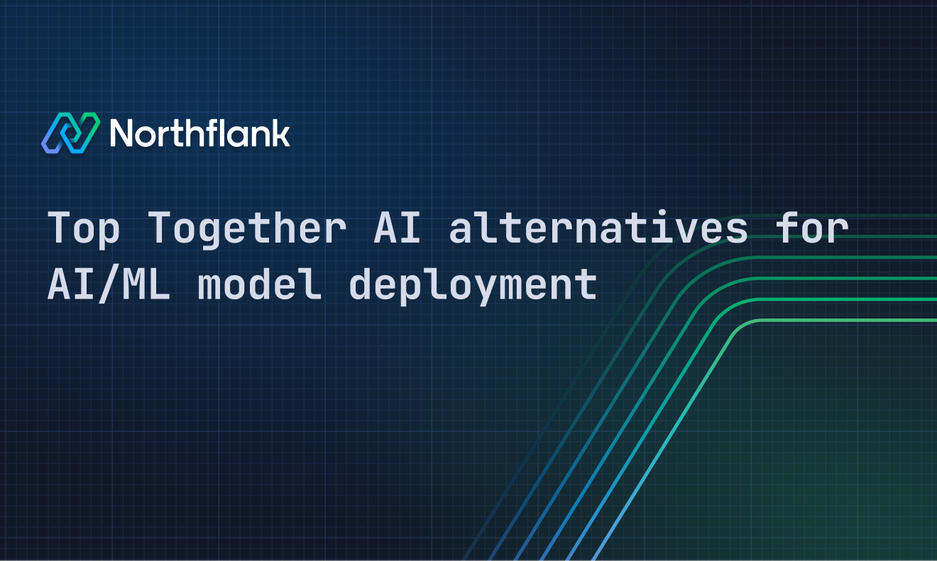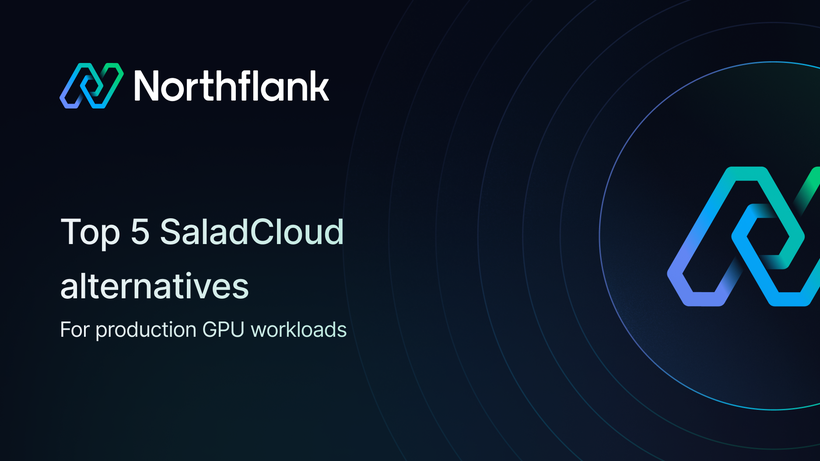

Top Together AI alternatives for AI/ML model deployment
You chose Together AI because you didn’t want to wrangle GPUs, manage model weights, or spin up an ML stack just to run an LLM.
And for a while, it was perfect.
Clean APIs. Fast inference. Instant access to LLaMA, Mistral, Mixtral. No infra setup. No DevOps. No drama.
But then you started to outgrow the defaults.
You wanted to fine-tune with your own data, but had to adapt to their pipeline.
You needed more visibility, but the logs only went so far.
You tried to push beyond basic prompt-response, and the platform pushed back.
Together AI is great for getting started with open-source models. It's fast, simple, and gets you to a working demo in minutes.
But once you start building AI features into your product, things get more complex, more custom, more production-grade, and the walls start closing in.
If you’re at that point, you’re not alone.
This guide walks through the best Together AI alternatives for teams who want to:
- Serve fine-tuned models with more control
- Go beyond text-only inference and rigid APIs
- Debug and monitor their stack like real engineers
- Scale without guesswork around limits or pricing
If you're short on time, here’s a snapshot of the top Together AI alternatives. Each tool has its strengths, but they solve different problems, and some are better suited for real-world production than others.
| Platform | Best for | Notes |
|---|---|---|
| Northflank | Full-stack ML apps with DevOps-grade flexibility | GPU containers, Git-based CI/CD, AI workload support, BYOC, and enterprise-ready features |
| Baseten | Custom model serving with great DX | Full control over Python serving logic, autoscaling, and built-in observability |
| Modal | Serverless Python workflows | Great for async-heavy workloads, scales to zero, no infrastructure needed |
| Replicate | Sharing public ML models easily | Ideal for demos and generative models, with public API hosting |
| Hugging Face | Simple LLM APIs from HF-hosted models | Fast setup for popular Hugging Face models, but limited customization |
| Ray Serve | Custom model routing and orchestration | Powerful for advanced routing logic, but requires more infra management |
⚡️ Pro tip: If you're currently juggling different platforms for GPU and non-GPU workloads, why not simplify? Northflank is an all-in-one developer platform that supports everything from deploying vector databases to running self-hosted LLMs with secure multi-tenancy, BYOC, and full-stack orchestration across clouds. You can try it free or book a demo to see how it fits your stack.
Together AI has become a popular choice for teams deploying LLMs without the overhead of running their own infra. It offers a fast path to serving open-source models with solid performance and simple APIs.
Here’s what makes it appealing:
- Instant access to open models like Mistral, LLaMA, and Mixtral — no need to manage GPUs, weights, or hosting
- Simple APIs, fast time to value — spin up endpoints and see results in minutes
- Competitive pricing for base-level inference and prompt-response workloads
- Hosted fine-tuning and LoRA support — helpful for domain-specific tweaks without major compute overhead
- Developer-friendly experience — solid docs, clean APIs, and a familiar feel for anyone used to OpenAI or Hugging Face
It’s an excellent launchpad, especially for teams that want to move quickly without touching infra. But when your needs go beyond basic inference, it can start to feel limiting.
Together AI makes it easy to get started with hosted models. But that simplicity starts to work against you once your needs grow. What feels smooth at first can turn into friction fast.
You don’t control where your models run or how they behave. There’s no infrastructure access, no way to manage latency zones, and limited performance tuning. If runtime matters, you're left hoping everything “just works.”
Platforms like Northflank give you deep control over your container environment — even letting you safely run untrusted, AI-generated code using secure runtime isolation. That’s critical for teams deploying fine-tuning jobs, LLMs, or customer-specific workloads.
Yes, fine-tuning is available, but only through Together's pipeline. You can't bring your own trainer or customize the process. If you already have established workflows or need special training behavior, you’ll hit a hard ceiling.
You get usage stats and a few basic metrics, but not much else. There's no token-level tracing, no latency breakdowns, and no visibility into GPU activity. When things slow down or costs spike, you're left guessing what happened.
There's no built-in support for deployment pipelines, versioned releases, or environment promotion. If you're trying to plug Together AI into a mature MLOps flow, expect to build a lot of scaffolding yourself. Platforms like Northflank are built with Git-based CI/CD at their core.
Together AI can be cost-effective at small scale, but prices rise quickly with usage or larger models. Since there are no strong forecasting tools or detailed usage reports, teams often get surprised by their bills.
Together AI runs in its own managed cloud by default. They do support Bring Your Own Cloud through Self-hosted and Hybrid deployments, which let you run workloads in your own AWS, GCP, or Azure environment. However, these options are only available on enterprise plans and require working directly with their team. That can be a challenge for teams that want to get started quickly without going through a sales process.
In contrast, Northflank lets you bring your own cloud from the beginning with a fully self-serve setup and no need to talk to sales.
Before switching platforms, it’s important to think beyond checkboxes. What looks simple today can turn into friction tomorrow if you don’t have the right building blocks. Here’s what to seriously evaluate when considering an alternative to Together AI:
Can you control the serving environment? If your model needs custom dependencies, non-Python services, or GPU-accelerated libs, managed runtimes might not cut it. You’ll want full container-level control — and ideally, the ability to bring your own image.
With platforms like Northflank, you can deploy any container, not just models, so your runtime is exactly what your app needs. No workarounds. No black boxes.
If you're deploying real-time APIs, latency matters. Cold starts, provisioning lag, and inconsistent scaling can break the user experience, especially for LLMs or vision models.
Look for platforms that let you keep containers warm, scale to zero when idle, and autoscale under load, all with GPU support. Northflank gives you fine-grained control over autoscaling and lets you keep hot replicas running, without paying premium prices.
The best deployment workflows match your team’s habits. Whether you’re a solo developer using CLI commands or a larger team pushing to staging via Git, you shouldn’t have to change how you work.
Git-based deploys, PR previews, CLI tools, and APIs should all be part of the story. Northflank, for example, supports GitHub-native workflows out of the box, perfect for tight CI/CD pipelines.
Not every ML model is just an API. Sometimes you need to ship a product, whether it’s a dashboard, an internal tool, or a fully interactive app. That means deploying both the frontend and backend together.
Many platforms silo inference from everything else. Look for alternatives that support full-stack deployment, not just model serving. Northflank lets you deploy Next.js, React, or any frontend framework alongside your database and APIs, all from the same repo, on the same platform.
Together AI’s usage-based pricing can spike as you scale, especially with GPU workloads. The right platform should let you control your cost structure, whether that means:
- predictable flat-rate containers
- cost-per-inference
- or autoscaling tuned to your real usage
Northflank gives you transparent pricing, and because you control your container runtime and scaling, you also control cost.
If you're building for finance, healthcare, or enterprise, compliance isn’t optional. Look for platforms that support SOC 2, HIPAA, GDPR, and secure audit logs, or at the very least, give you the ability to run in your own secure cloud.
Northflank is SOC 2-ready, it supports secure features like RBAC, audit logs, and SAML out of the box, all with multi-tenant isolation and BYOC.
Many teams don’t want to run models on someone else’s infrastructure. Whether it's for data residency, privacy, or integration with your existing stack, running in your own cloud can be critical.
Northflank supports BYOC natively to deploy into your own AWS, GCP, or Azure account without enterprise pricing or sales calls.
Manual deploys don’t scale. Look for platforms that treat CI/CD as a first-class feature. Git-based deploys, automated rollbacks, staged environments, and secrets management should be built in, not bolted on.
Northflank was designed with modern DevOps in mind, including Git triggers, environment previews, and built-in CI integrations.
Here is a list of the best Together AI alternatives you can find. In this section, we talk about each platform in depth, its top features, Pros, and Cons.
Northflank isn’t just a model hosting tool; it’s a production-grade platform for deploying and scaling real AI products. It combines the flexibility of containerized infrastructure with GPU orchestration, Git-based CI/CD, and full-stack app support.
Whether you're serving a fine-tuned LLM, hosting a Jupyter notebook, or deploying a full product with both frontend and backend, Northflank gives you everything you need, with none of the platform lock-in.

Key features:
- Bring your own Docker image and full runtime control
- GPU-enabled services with autoscaling and lifecycle management
- Multi-cloud and Bring Your Own Cloud (BYOC) support
- Git-based CI/CD, preview environments, and full-stack deployment
- Secure runtime for untrusted AI workloads
- SOC 2 readiness and enterprise security (RBAC, SAML, audit logs)
Pros:
- No platform lock-in – full container control with BYOC or managed infrastructure
- Transparent, predictable pricing – usage-based and easy to forecast at scale
- Great developer experience – Git-based deploys, CI/CD, preview environments
- Optimized for latency-sensitive workloads – fast startup, GPU autoscaling, low-latency networking
- Supports AI-specific workloads – Ray, LLMs, Jupyter, fine-tuning, inference APIs
- Built-in cost management – real-time usage tracking, budget caps, and optimization tools
Cons:
- No special infrastructure tuning for model performance.
Verdict: If you're building production-ready AI products, not just prototypes, Northflank gives you the flexibility to run anything from Ray clusters to full-stack apps in one place. With built-in CI/CD, GPU orchestration, and secure multi-cloud support, it's the only platform designed for teams who need speed and control without getting locked in.
Baseten helps ML teams serve models as APIs quickly, focusing on ease of deployment and internal demo creation without deep DevOps overhead.

Key Features:
- Python SDK and web UI for model deployment
- Autoscaling GPU-backed inference
- Model versioning, logging, and monitoring
- Integrated app builder for quick UI demos
- Native Hugging Face and PyTorch support
Pros:
- Very fast path from model to live API
- Built-in UI support is great for sharing results
- Intuitive interface for solo developers and small teams
Cons:
- Geared more toward internal tools and MVPs
- Less flexible for complex backends or full-stack services
- Limited support for multi-service orchestration or CI/CD
Verdict:
Baseten is a solid choice for lightweight model deployment and sharing, especially for early-stage teams or prototypes. For production-scale workflows involving more than just inference, like background jobs, databases, or containerized APIs, teams typically pair it with a platform like Northflank for broader infrastructure support.
Curious about Baseten? Check out this article to learn more.
Modal makes Python deployment effortless. Just write Python code, and it handles scaling, packaging, and serving — perfect for workflows and batch jobs.

Key features:
- Python-native infrastructure
- Serverless GPU and CPU runtimes
- Auto-scaling and scale-to-zero
- Built-in task orchestration
Pros:
- Super simple for Python developers
- Ideal for workflows and jobs
- Fast to iterate and deploy
Cons:
- Limited runtime customization
- Not designed for full-stack apps or frontend support
- Pricing grows with always-on usage
Verdict:
A great choice for async Python tasks and lightweight inference. Less suited for full production systems.
Replicate is purpose-built for public APIs and demos, especially for generative models. You can host and monetize models in just a few clicks.

Key features:
- Model sharing and monetization
- REST API for every model
- Popular with LLMs, diffusion, and vision models
- Built-in versioning
Pros:
- Zero setup for public model serving
- Easy to showcase or monetize models
- Community visibility
Cons:
- No private infra or BYOC
- No CI/CD or deployment pipelines
- Not built for full-stack production-ready AI apps
Verdict:
Great for showcasing generative models — not for teams deploying private, production workloads.
Hugging Face is the industry’s leading hub for open-source machine learning models, especially in NLP. It offers tools for accessing, training, and lightly deploying transformer-based models.

Key Features:
- Model Hub with 500k+ open-source models
- Inference Endpoints (managed or self-hosted)
- AutoTrain for low-code fine-tuning
- Spaces for demos using Gradio or Streamlit
- Popular
transformerPython library
Pros:
- Best open-source model access and community
- Excellent for experimentation and fine-tuning
- Seamless integration with most ML frameworks
Cons:
- Deployment and production support is limited
- Infrastructure often needs to be supplemented (e.g., for autoscaling or CI/CD)
- Not designed for tightly coupled workflows or microservice architectures
Verdict:
Hugging Face is a powerhouse for research and prototyping, especially when working with transformers. But when it comes to robust deployment pipelines and full-stack application delivery, it’s often used alongside a platform like Northflank to fill the operational gaps.
Ray Serve is part of the Ray ecosystem — built for fine-tuned inference flows, multi-model routing, and real-time workloads.

Key features:
- DAG-based inference graphs
- Supports multiple models per API
- Fine-grained autoscaling
- Python-first APIs
Pros:
- Powerful for complex inference pipelines
- Good horizontal scaling across nodes
- Open source and flexible
Cons:
- Requires orchestration and infra setup
- Not turnkey — steep learning curve
- No built-in frontend or CI/CD
Verdict:
Perfect for advanced teams building composable model backends. Just be ready to manage the stack.
Your choice of Together AI alternative depends on your priorities:
| Feature / Platform | Northflank | Baseten | Modal | Replicate | Hugging Face | Ray Serve |
|---|---|---|---|---|---|---|
| Model runtime control | Full container & runtime flexibility | Python-only | Limited | No custom runtimes | Limited | Full control (manual setup) |
| GPU support | First-class support with autoscaling | Available | Serverless GPU jobs | Limited availability | Basic access | Manual provisioning required |
| Frontend/backend support | Full-stack apps (Next.js, APIs, databases) | Basic app builder | None | None | Gradio/Spaces only | None |
| CI/CD & Git deploys | Git-native CI, preview environments, pipelines | Limited | Manual workflows | No Git integration | Partial | No CI/CD built-in |
| Bring Your Own Cloud (BYOC) | Native AWS, GCP, Azure support | No | No | No | Enterprise only | Self-hosted |
| Observability | Built-in logs, metrics, usage tracking | Basic monitoring | Minimal | None | Limited | Custom setup needed |
| Security & compliance | SOC 2-ready, RBAC, SAML, audit logs | Basic features | Limited | No enterprise security | Varies by tier | No built-in access control |
| Multi-modal workloads | Full support (LLMs, vision, custom models) | Text models only | Python-based (text/audio) | Vision and generative models | Hugging Face models only | Supports any model (manual setup) |
| Pricing model | Predictable usage-based pricing | Usage-based with potential spikes | Usage-based | Usage-based | Tiered, usage-based | Full control (self-hosted) |
| Best suited for | Teams deploying real AI products to prod | Demos and internal tools | Async Python tasks and jobs | Public model endpoints | Research and experimentation | Infra-heavy ML platforms |
Most Together AI alternatives fall into one of two categories:
- Lightweight tools for demos and prototypes
- Heavy infrastructure requiring manual setup or DevOps expertise
Northflank is different:
- Gives you full runtime control like Ray or Modal
- Includes frontend/backend hosting like Vercel or Railway
- Offers CI/CD, observability, security, and GPU support in one platform
- Supports BYOC so you can run in your own AWS/GCP/Azure environment
- Ideal for shipping, scaling, and securing production-grade AI apps
Together AI is a great launchpad; it gets you to a working LLM fast, without worrying about infrastructure. But once your needs grow, custom models, full-stack workflows, and tighter control over scaling and cost, the platform can start to feel like a box.
If you're at that point, you don’t need to settle for more limitations.
Platforms like Northflank are built for teams that want freedom without friction, container-native deployments, GPU orchestration, Git-based CI/CD, full-stack support, and the option to run in your cloud, not someone else's.
Whether you're shipping an AI product to real users or just want more control over your stack, Northflank gives you the tools to build like a real software team. Try Northflank for free and see how fast you can go from model to production. Or book a demo to explore what your stack could look like with Northflank in the loop.


